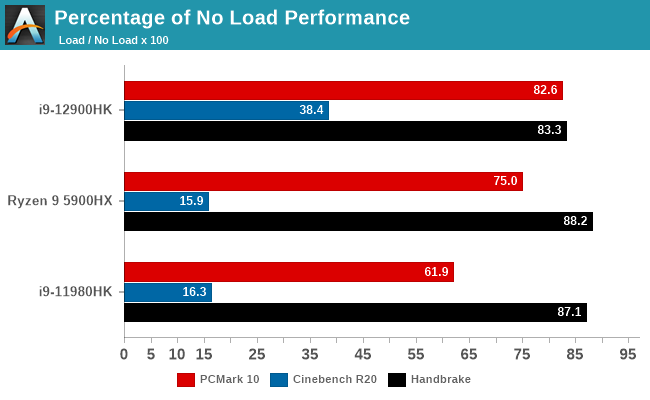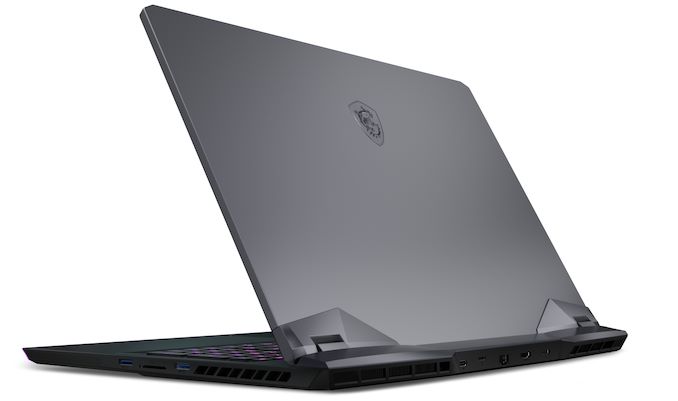Intel Alder Lake-H Core i9-12900HK Review: MSI's Raider GE76 Goes Hybrid
by Brett Howse on January 25, 2022 9:00 AM EST- Posted in
- CPUs
- Intel
- MSI
- Laptops
- Alder Lake
- GE76 Raider
- 12th Gen Core
- Alder Lake-H
Initial Thoughts
Intel has been consistent over the last several years to bring their low-power processors to market first, and then move towards the higher-performance platforms and desktops. With the laptop market being the majority of sales, this has made a lot of sense, but it most certainly has left the desktop crowd at a disadvantage. With Alder Lake, Intel has flipped that around completely by launching the desktop products first, and are now just moving down to high-performance laptops, and then finally low-power notebooks. The Core i9-12900HK at the heart of the MSI Raider GE76 is our first taste of Alder Lake in a portable system, and it tastes delicious.
The new hybrid CPU design delivers in multiple ways. Outright performance easily exceeds everything else on the market. The new Golden Cove P-Cores offer a significant uplift in terms of instructions-per-clock (IPC) and allow Intel to regain the single-thread performance crown. Having twenty threads available in a laptop processor also gives Intel the multi-threaded performance lead.
Perhaps the most impressive result though is Intel’s Thread Director, which provides very impressive system responsiveness even when the system is at 100% CPU load. Tasks that are being done in the background are still done quickly, but no longer at the expense of the user, and without having to manually adjust thread priority. This is a major win.

The supplied MSI Raider GE76 with the i9-12900HK and GeForce RTX 3080 Ti for Laptops also showcased increased gaming performance, although the increases were more subtle than the system performance results. At 1920x1080, the Alder Lake system almost universally provided a reasonable uptick in gaming performance, although the 3080L Ti GPU did not significantly move the yardstick at UHD resolutions.
Intel has also been able to integrate the CPU and chipset into one package for the 12th generation H-Series processors, and that System-on-Chip provides a lot of connectivity and expansion options, as well as compatibility with four different memory choices in DDR4, DDR5, LPDDR4, and LPDDR5. There is support for four Thunderbolt 4 controllers, as well as two by four lanes of PCIe 4.0 for storage, and another eight lanes for graphics and an additional twelve lanes of PCIe 3.0. Intel now also includes Iris Xe-LP graphics in their H-Series, with the full 96 Execution Units on tap with the Core i9-12900HK.
The one downside from sampling the MSI Raider GE76 was that it's a laptop designed to show off Alder Lake at its best with regards to performance, but at the expense of more mobile-friendly matters such as portability, energy efficiency, and battery life. Case in point: despite having the largest possible battery allowed in a notebook at 99.9 Wh, the base system power draw of the Raider was significant, making battery life poor and masking any changes that would have been a result of the CPU. Intel is aiming Alder Lake-H at everything from luggable desktop replacements such as the Raider to 14-inch ultraportable laptops, so there is a second side to Alder Lake that we've still yet to see. Once more laptops start shipping – especially the U-Series with LPDDR5 – we should get a much better feel for how the hybrid CPU design does when the device is running off the battery.
Thankfully, the lack of battery life was really the only negative for the MSI Raider GE76. It offers plenty of cooling, a great display, and offers the most potent laptop GPU on the market. The Tiger Lake version was the quickest laptop we had tested, but the new Alder Lake one takes things to another level. It is simply one of the best gaming notebooks on the market right now, and it's easy to see why Intel picked this laptop to show off the performance capabilities of Alder Lake-H.
Alder Lake appears to be a significant step forward for Intel, with commanding single-threaded performance, exceptional multi-threaded performance, and the benefits of Thread Director to increase system responsiveness. Alder Lake was a step forward for desktops, but likely an even larger step forward for notebook computers. Intel has delivered tremendous performance across the board and the gap is not even close. 2022 is shaping up to be an exciting year again.












153 Comments
View All Comments
Netmsm - Tuesday, January 25, 2022 - link
"High? not at all" said Patrick Gelsinger.:)))
maroon1 - Wednesday, January 26, 2022 - link
115w is max power for shot period. sustained power consumption is 85w in extreme performance modeAnd 75w when using balanced mode but you lose 3% in cinebench
undervolted_dc - Wednesday, January 26, 2022 - link
... and spec sheet says 45w, but probably during bench are using the full power boost.. and gets benchmarked against 45w ( with boost at 54w) in performance..e cores seems to no help in low performance tasks also.. seems less efficient than amd despite having the complexity to manage hybrid cores in the OS
Spunjji - Thursday, January 27, 2022 - link
It's Intel's strategy ever since they got stuck on 14nm. Prior to that, they kept dropping power while incrementing performance, leading to a progressively improving overall experience (better sustained power, less bulky devices, etc.)Then AMD got back in the game and Intel had to compete somehow, so they started raising their TDP ratings to get benchmarks that look good. The results are easy to see when you look at sites like Notebookcheck that measure performance of large groups of devices: Intel get good benchmarks, but performance drops quickly under sustained use in anything other than a DTR, and there's a massive error bar around the average performance of an Intel mobile CPU because it's dependent on how well the chassis can remove 45W+ of heat (even the Ultra Mobile ones).
sandeep_r_89 - Monday, January 31, 2022 - link
Higher battery capacity doesn't help win benchmarks........bogamia - Tuesday, January 25, 2022 - link
wonder how it would perform against Rembrandt which will presumably offer 30% better mt uplift.Spunjji - Thursday, January 27, 2022 - link
I wouldn't expect to see an increase like that in practice. Rembrandt may be a little faster than Cezanne, but probably not a lot.If you're one of the majority of people who buy a device that's designed to cool 45W sustained, though, then it'll be less of a disappointment than Alder Lake.
vlad42 - Friday, January 28, 2022 - link
Maybe, maybe not. The base clock does appear to have gone up from 1.9 GHz in the 5800U to 2.7 GHz in the 6800U, a 42% increase! Granted, it is possible the 2.7 GHz base clock is only when the chip is in 28W mode - it really was not clear from the slide.We also do not know how much benefit RDNA2 is bringing over Vega in terms of energy efficiency (there may be more thermal/power budget available to the Zen 3 cores), the improvements in 6N vs 7N, or the yield improvements/better binning now that the process is even more mature - 6N is still just a variant of 7N after all.
While I would normally agree with you, we clearly need more information to know for certain. The Ice Lake to Tiger Lake improvements were pretty significant and the changes Intel made look to be fairly similar to what AMD has done here.
Samus - Saturday, January 29, 2022 - link
I agree. I don't think AMD is going to take the IPC performance crown back here unless they can considerably scale up clock speed at the cost of efficiency like a Black Edition part.The fact is all these new CPU's are SO fast that it's Lamborghini's vs Ferrari's. I think people are going to prefer the one that has double the MPG at a virtually unnoticeable performance penalty.
FwFred - Wednesday, February 2, 2022 - link
How does higher clock speed help IPC exactly? Let's just call it single thread performance and leave IPC to microarchitectural discussions.